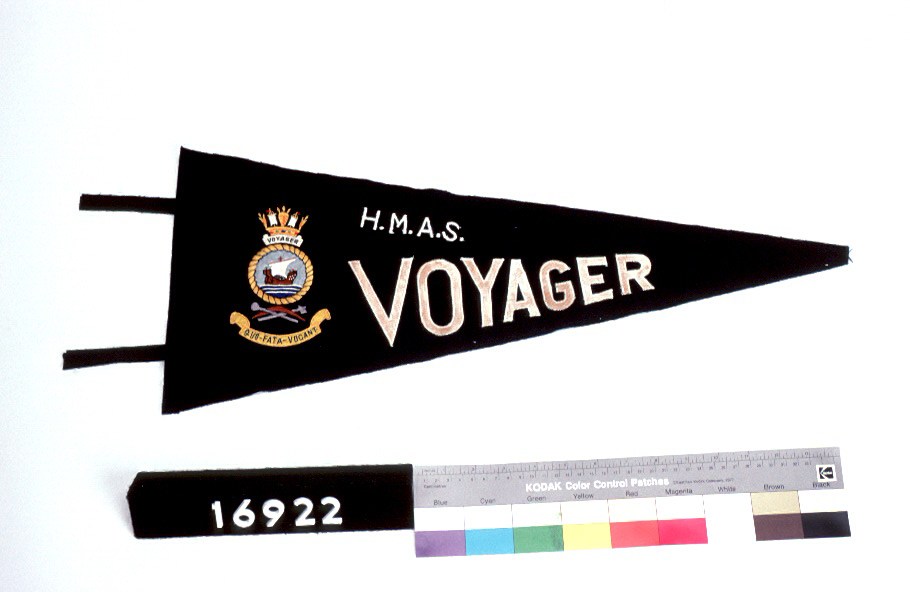

HMAS VOYAGER pennant flag. ANMM Collection gift from M Hampson
The Royal Australian Navy was undertaking routine exercises off Jervis Bay on the NSW south coast and was ending the day with night flying exercises for the aircraft of the carrier HMAS Melbourne. The Daring class destroyer HMAS Voyager (sister ship to the museum’s Vampire) was in the role of plane guard, or rescue destroyer. Voyager’s job was to pick up any airmen if the exercise went wrong and they crashed. It was also the destroyer’s job to stay clear of the aircraft carrier.
The exercises were going well until the start of the 8.40 pm manoeuvre. Melbourne’s commanding officer Captain Robertson ordered Voyager to take her position – behind Melbourne and off to the port (left) side. At that stage Voyager was sailing just ahead of the carrier on the starboard (right) side. She immediately turned to starboard as if to loop around behind the carrier into position; but then turned to port. The bridge crew on Melbourne thought she was going to turn to starboard again undertaking a fishtail or zigzag course to slow her momentum. But by the time they realised Voyager was still turning to port – and therefore would pass in front of Melbourne – it was too late to avoid a collision.
Captain Robertson immediately ordered Melbourne full astern; Captain Stevens ordered Voyager full ahead hard a starboard in a futile attempt to avoid each other. But the momentum and size of the carrier meant it was physically unable to slow or change course enough to avoiding hitting Voyager. And hit the destroyer she did – just aft of the bridge and slicing Voyager in two. The senior officers on the bridge of HMAS Voyager were killed on impact.
Within seconds Captain Robertson had ordered boats into the water, nets over the side of the carrier for survivors to clamber up and helicopters into the air. In this state of confusion, darkness and panic training swung into place and true heroes were made. The bow of Voyager had heeled sharply onto its starboard side and then turned upside down. Some 60 men were in the forward cafeteria and as water poured in they tried to get out through the escape hatches – but some wouldn’t open. The senior sailor of Voyager was Jonathan ‘Buck’ Rogers and he took control of the situation, sending sailors to hatches that would open and trying to open the jammed ones. When he realised that it was too late he was heard leading the men in prayer. The bow section sank completely in just under 10 minutes. Meanwhile the aft section stayed afloat, sinking slowly, until just after midnight.
Of a ship’s complement of 314, 82 men were never to return home.
The survivors who were plucked from the water were covered in fuel oil, vomiting, cut, bruised, and broken and in shock. Within 15 minutes the first survivors were being taken on board the carrier. Some were taken directly to HMAS Creswell in Jervis Bay while Melbourne steamed to Sydney – and that is the iconic photograph most people remember, Melbourne’s damaged bow.
In the decades that followed, public scrutiny of private lives and naval procedures kept the tragedy in the news. There were two Royal Commissions, the first acknowledging the lack of a proper lookout and response on the part of the Voyager bridge officers but also criticising the Melbourne bridge crew for not questioning the course Voyager was taking. The second Commission exonerated the Melbourne men – too late though for Captain Robertson who had resigned from the navy – and concluded the collision was due to a mistake by Voyager and that Captain Stevens was medically unfit for command at the time. He had been suffering from a duodenal ulcer and was at times apparently self-medicating with alcohol. As none of Voyager’s bridge officers survived the collision we may never know why the port course was taken.
After the Royal Commissions, the Naval Board put into place a series of reforms and safety changes on board ships and reviewed many of its policies and procedures. It was also made accountable to the wider government and public community.
For many of the men of Voyager and Melbourne and their families this has been an ongoing struggle. The survivors were given seven days’ leave, replacement uniforms and vouchers to get home. And then they returned to duty and were deployed to other RAN ships. Many suffered flashbacks and nightmares, anger and alcohol issues, problems with confined spaces and obsession with safety measures. Life was never the same again. Compensation claims were initially dismissed by the High Court but this was overruled in 1982. In the 1990s both Voyager and Melbourne men and their families pursued claims against the Government in court, with the last case being closed in 2009 – 45 years after the tragedy unfolded.

Wristwatch worn by Mike Hallen on the night of HMAS VOYAGER and HMAS MELBOURNE collision. ANMM Collection Gift from M W J Hallen
Even more unfair though has been the action of one of the main law firms acting on behalf of the men – a case against them is being heard today of allegations of gross overcharging and major accounting faults.
The men and women of the Royal Australian Navy work and train in an exacting and dangerous environment and deserve our respect. Today we mark the worst peacetime loss for our navy – may it never happen again.
Lindsey Shaw
Senior Curator (retired)
